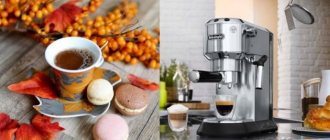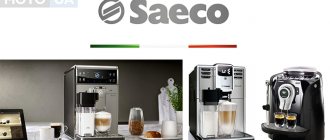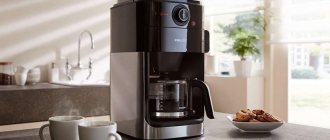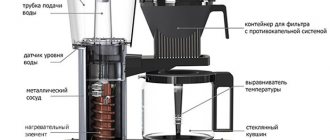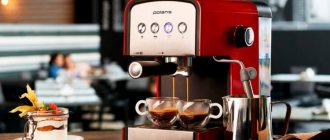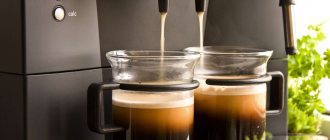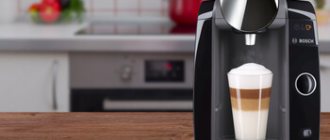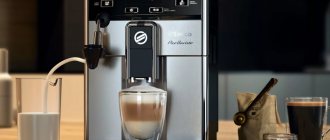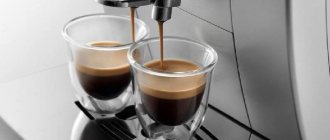The most popular coffee drinks with milk are based on aromatic and strong espresso Italiano. The most complete extraction, preserving the aroma and taste of ground roasted grains, occurs at elevated pressure and without boiling. Therefore, at home, high-quality espresso with delicious foam can only be prepared using a carob coffee maker.
History of the carob coffee maker
The prototype of espresso coffee makers was a compression-type machine created by the Frenchman Edouard Loisel de Santé in the 19th century. In 1901, Italian engineer Luigi Bezzera received a patent for a coffee machine that very quickly prepared rich and strong coffee.
Bezzera did not engage in production and in 1903 sold his patent to industrialist Desiderio Pavoni, who 2 years later began producing coffee machines. However, due to a design flaw, the coffee grounds in them overheated, resulting in bitter coffee.
Pavoni's commercial success did not go unnoticed, and soon several more companies began producing coffee machines. Over the next 50 years, large companies were founded that still exist today:
- Simonelli (Italy) – produces medium and high performance espresso machines;
- Faema (Italy);
- Gaggia (Italy) - currently purchased by Philips as part of the Saeco company;
- JURA Elektroapparate AG (Switzerland).
The optimal parameters of a coffee machine for making espresso were determined experimentally:
- pressure in the working chamber is about 9 bar;
- water temperature ranges from 86 to 93 ºС.
Coffee maker Gaggia 1948 goals
The founder of Gaggia, Giovanni Achille Gaggia, managed to create technology that improved the quality of espresso. Gaggia patented the use of a screw piston to force water through pressed coffee powder. Contact with steam was eliminated, and the bitterness that appeared due to high temperature was removed from the taste of espresso. So-called lever (piston) coffee makers can still be found in cafes and bars, although automatic and super-automatic machines are now in service.
In the second half of the 20th century, the dimensions of coffee machines decreased significantly; coffee makers appeared not only for catering establishments, but also for the home. When designing new devices, electric heat exchangers, rotary pumps, and an internally heated cooking chamber were used. The predecessors to modern home espresso machines were released in 1961:
- "Elektra Micro Casa a Leva";
- "La Pavoni Europiccola".
In 1964, the La Pavoni Professional Lever coffee maker, specially designed for home use, went on sale.
Types of carob coffee makers and coffee machines
Based on the operating principle, carob coffee makers are divided into 2 groups:
Features of steam coffee machines
Steam coffee makers, or Steam-Espresso, are much cheaper than pump coffee makers, but the quality of the drink differs in strength and taste.
The steam generated as a result of boiling water in the tank, when a pressure reaches 4–5 bar, opens the valve and enters the working chamber (inside the filter holder). Then the steam passes through a compressed tablet of ground coffee, then the condensate flows into a cup placed in advance. The drink may taste bitter because the steam temperature is too high, and due to the low pressure (below 9 bar), the contact of the coffee grounds with the steam lasts quite a long time.
Steam-Espresso example
It is difficult to obtain classic espresso in a steam coffee maker; the result in consistency and taste is closer to lungo, although the caffeine content will be high.
- steam coffee makers are cheaper than pump coffee makers;
- do not create noise during operation;
- The drink turns out to be invigorating.
- Preparing a cup of coffee takes longer than with a pump coffee maker;
- The drink turns out a little watery.
Features of pump coffee makers
Pump-type coffee makers (also called Pump-Espresso) are considered a better option than steam ones. Pump coffee makers are equipped with an electromagnetic pump that drives water through a thermoblock. In the boiler, the water is heated to a temperature no higher than +93 ºС, creating high pressure, which in the filter can reach up to 10, and in some models – up to 15 bar.
Pump-Espresso
Drinks prepared in Pump-Espresso coffee makers are better, and the taste of the coffee beans is revealed more fully.
- the drink is rich, without particles of grounds;
- a lush coffee foam (cream) is formed;
- preparing a cup of coffee takes 20-30 seconds;
- the taste lacks sourness and bitterness.
- the pump pump is noisy;
- quite high price.
Rating of the best coffee makers
Before purchasing, it would be a good idea to study the ratings of carob coffee makers. The TOP steam devices include the following models:
- Polaris PCM 4002 . The device is multifunctional and can last for a long time;
- DeLonghi ESAM 2600. Considered one of the best carob-type coffee makers. The espresso is of the same quality as using coffee machines. True, such a device is quite expensive;
- Kenwood ES 020 . This device allows you to get a quality drink. The unit is reliable, with a metal holder, easy to operate, and its price is relatively low;
- Gaggia Gran Prestige. The body of this model is metal. Therefore, the device is considered to be as reliable as possible. It produces strong, aromatic coffee;
- Philips Saeco HD8323 . Belongs to the group of budget options. It is reliable and easy to use.
DeLonghi ESAM 2600
Gaggia Gran Prestige
Kenwood ES 020
Philips Saeco HD8323
Polaris PCM 4002
Among the best pump-type carob coffee makers are the following models:
- Delonghi EC 680 M/R/BK Dedica. Made in retro style. The body is metal and looks beautiful. The horn is also made of metal. There is a descaling function. The pressure level reaches 15 bar. Another advantage is the removable horn. Due to this, cleaning does not cause any difficulties;
- Vitek VT-1516. A reliable device equipped with an automatic cappuccino maker and a water level indicator. The presence of two metal horns is noted;
- Krups XP 3440. Budget option. The model is powerful and makes it possible to prepare high-quality espresso. The holder is made of metal;
- Polaris PCM 1515E. Semi-automatic device. The controls are simple. Prepares espresso, Americano and cappuccino;
- Kitfort KT-706. Budget semi-automatic model. It is reliable. Easy to maintain.
Kitfort KT 706
Delonghi EC 680
Polaris PCM 1515E
Krups XP 3440
Vitek VT 1516
Principle of operation
Unlike most mechanisms in which coffee is mixed with water, a carob coffee machine has a completely different operating principle.
In devices of this type, hot water or steam under pressure passes through compressed ground coffee, absorbing maximum taste and aroma, after which it condenses in a special chamber, turning into a drink.
There are two types of such coffee makers:
- Pump-action . It heats the water to 95 degrees, after which it is forced through a coffee horn under a pressure of 15 bar. This method allows you to preserve the nutrients and aroma of coffee. The device handles one cup of coffee in about a minute and a half.
- Steam . It differs from the pump type in the degree of heating, pressure and method of water supply. Water in a closed tank is heated to boiling and steam formation. When the pressure in the tank reaches 4 bar, the valve opens and steam flows through the coffee in the cone. Coffee prepared this way may have a less pronounced aroma, but contains more caffeine, which gives it an invigorating effect. The preparation time for the drink is two minutes.
The result is coffee without any added grounds. This method allows you to prepare a drink while preserving the original taste of the beans. Another significant advantage of the method is the speed of preparing coffee.
This is why carob devices are practically indispensable both in the office and at home, where you don’t want to waste precious morning moments on a long cooking process.
At first glance, the process of making coffee using a holder may seem more complicated compared to a drip-type device. But the finished drink from a drip coffee maker is significantly inferior to coffee prepared in a carob in terms of taste characteristics and richness of aroma.
Tip No. 8. Assessing consumer properties
The ergonomics of a carob coffee machine is an important indicator that affects the degree of satisfaction of device owners. It should be compact and oversized, especially for home use. It is necessary to take into account the target group of users: the older generation needs coffee machines with the most intuitive interface. Build quality affects reliability, which includes a number of indicators: durability, safety and maintainability. Purchasing a coffee machine should not be a planned expenditure of money, but an investment in quality equipment with a long service life.
How to use a carob coffee maker (coffee machine)
Preliminary preparation
Making coffee, like any drink, usually begins with preparing the right amount of water. Inside the design of the coffee machine there is a heating element, on the surface of which plaque or, in other words, scale may form. Therefore, manufacturers insist on using purified, filtered water. This can be done using a regular household filter, boiling or freezing water.
Remember that untreated tap water is not recommended for brewing coffee.
Next, we will look at how to properly brew coffee in several of the most popular types of coffee machines.
You will need bean coffee, ground in a burr grinder to medium degree, or commercial fine-ground espresso coffee.
Can the device be used to make cocoa?
Some users may want to use the machine to prepare other drinks, such as cocoa.
However, cocoa and coffee are prepared differently. Cocoa powder consists of very small grains that are compressed too much and may not allow steam to pass through the mass.
In addition, the fine consistency of the powder can clog the holes in the holder. Therefore, it is better not to experiment with preparing cocoa in a coffee machine.
Instructions
- Fill the tank with bottled water with a salt concentration ranging from 75 to 250 mg/l.
- Fill the filter with coffee powder and tamp it with tamper. A measuring spoon holds 7–8 g, exactly for 1 serving, if there is a second, then for 2 servings – 14–16 g.
- Carefully insert the horn into the holding device and turn the handle all the way to the right.
- Start the pre-wetting function, if the coffee maker has one.
- Turn the switch to the “On” position.
- Wait until the indicator light comes on, indicating that the water has warmed up.
- Place the heated cup on the grill covering the tray and turn on the button (or turn the switch) to release the finished drink.
- If you want to prepare milk foam, you need to use the “Steam” function and place a pitcher or a glass of milk under the plastic nozzle of the cappuccino maker. Turn on the cappuccino maker. Use a spoon to add milk foam to the cup of coffee.
- After the cycle ends and the cone has cooled, turn the handle to the left, carefully remove the filter with the wet tablet from it and throw it away. Rinse the equipment with running water, being careful not to leave grains of ground coffee on the edges of the filter and horn.
- If the tray is filled with liquid, you must carefully remove it, pour the contents into the sink and rinse under running water, otherwise mold may appear.
- Unplug the coffee maker or leave it in standby mode if this is not your last cup of coffee for the day.
Improving the taste of the drink
Choosing the right coffee
Grinding
A drip coffee maker requires coarse grinding. Not as coarse as for a French press or Chemex, but also coarser than for an espresso machine. On packs of already ground coffee it is usually marked with a teapot design.
Ground coffee Lavazza “Crema e Gusto”, 250 g 258 rub.
Ground coffee Lavazza “Qualita Oro”, in a tin can, 250 g 400 rub.
Ground coffee Coffesso “Classico Italiano”, 5 sachets -25%
110 rub. 146 rub.
Ground coffee Jardin “Espresso di Milano”, 250 g 221 rub.
Ground coffee Lebo “Extra”, for Turkish, 75 g 61 rub.
Ground coffee Living Coffee “Espresso”, 200 g 172 rub.
Ground coffee Jockey “Eastern style”, 450 g 334 rub.
Ground coffee Fresco Arabica Barista, for brewing in a cup, 100 g -50%
90 rub. 179 rub.
Choose ground coffee on TEA.ru
The finer the grind used, the more bitter the coffee will be. The reason is the rather long extraction time (5–7 minutes): water extracts the maximum from coarsely ground coffee, while finely ground coffee is overextracted during this time.
Roasting.
For a filter coffee maker, light or medium roast coffee is recommended. Dark roasting will add an unpleasant bitterness to the drink.
A little trick: Some experts recommend preheating the coffee pot with hot water. In a heated vessel, the flavor and aromatic qualities of coffee are better revealed.
We use good water
Not for coffee
Use tap water, distilled and boiled.
You can
- filtered (softening and mineralizing filters) and bottled.
Ideal water for any method of preparing coffee should be pH-neutral and have the following parameters: calcium content - 68 mg/l, total alkalinity - 40 mg/l, sodium amount - 10 mg/l, total mineralization (TDS) 150 mg/l . We wrote in more detail about the effect of water on the taste of coffee in this article.
Malfunctions of carob coffee makers
A semi-automatic or automatic coffee machine is a rather complex device with fine tuning. Repairs will not be cheap, but tampering with the device yourself can cause considerable harm. You should not repair the electrical system unless you have the appropriate training and skills in using instrumentation. Everything related to electronics and heating elements should be left to specialists, especially if the warranty period has not yet expired.
The main thing is to properly and regularly care for the coffee maker, then there will be few malfunctions.
A carob coffee maker, the function of which is only to prepare a drink using ground coffee, is also a serious mechanism. But if adding water, filling and cleaning the horn, emptying the drip tray, and flushing all systems from contaminants is done manually, then you can fix some problems yourself.
Tip #2: The importance of the material and number of horns
The horn is a small part of the coffee machine, the design of which determines the taste characteristics of the drink. It is made of plastic and metal. Note that in coffee machines with metal horns, the coffee turns out dense with a high, nut-colored milk foam. Plastic elements ensure the production of a watery drink with a sour taste.
We recommend choosing metal horns to fully enjoy your favorite espresso or cappuccino. An important point is also their quantity: for an office or a large family it is better to purchase a coffee machine with two horns.
Cons of carob coffee makers
The pros and cons of carob coffee makers largely depend on the properties of the particular machine. This design itself allows you to get really good and tasty coffee, therefore, if you do not buy a cheap model, but spend money on an expensive and high-quality one (in this case there is a direct relationship between price and quality), then such a coffee maker will have practically no disadvantages. The price also depends on the types of coffee that are available for preparation in a particular carob coffee maker (for example, espresso, cappuccino, latte and others).
At the same time, any coffee maker, of course, loses to a coffee machine, which has a much larger number of settings and functions, which will allow you to turn the process of making coffee into real creativity.
The main disadvantage of a carob coffee maker is that it almost never has a built-in coffee grinder. Also, to use it, you will definitely need a tamper - this is a special tool for pressing coffee into a cone.
A carob coffee maker is usually quite bulky; one might say that it is closer to a household appliance, but this point is not always a disadvantage.
Tip #6: Modification for Customer Satisfaction
We recommend paying attention to the additional features of the coffee machine that simplify the operation process:
- protective functions include automatic shutdown when overheating;
- the “Stop” button allows you to interrupt the process if various malfunctions occur;
- automatic descaling;
- the IFD milk frothing system produces high foam, which, according to coffee lovers, indicates the quality of the prepared product.
This list is incomplete and is constantly expanding, which indicates a high demand for carob coffee machines and improved design solutions from brands.
What drinks can be prepared in a carob maker?
In a carob coffee maker you can prepare various variations of coffee drinks:
- classic espresso;
- latte;
- cappuccino;
- look;
- Irish coffee.
Let's look at recipes for making coffee from a carob coffee maker.
Classic espresso
Espresso is perhaps the most popular strong and at the same time simple drink in terms of preparation.
The recipe for making espresso in a carob coffee maker is as follows:
- Take 7-9 grams of freshly ground, finely roasted beans and 30 ml of water.
- Pour coffee into the cone, compact the mass using a tamper, and place it in the coffee machine.
- All you have to do is turn on the unit and after 25-30 seconds 30 ml of delicious, aromatic espresso with a reddish, dense foam will be prepared.
Latte
Ingredients you will need:
- freshly ground fine grains - 1 tablespoon;
- water – 40-50 ml;
- milk – 200 ml;
- cinnamon, crushed nuts – 2-3 grams.
We will prepare latte according to the following algorithm:
- First of all, let's take suitable dishes. A multi-layer latte is best poured into a tall Irish glass.
- Brew espresso in a coffee machine according to the above recipe, using 40-50 ml of water.
- Using the paranello attachment, beat the pre-cooled milk until thick foam.
- Pour espresso into a glass, and on top, carefully, along the wall, pour foamed milk.
- Decorate the drink with cinnamon and crushed nuts.
Cappuccino
There are several recipes for making this delicious drink.
Classic recipe
Prepare cappuccino as follows:
- Take 1.5 tsp. freshly ground fine grains, 100 ml of milk. Pour 100 ml of water into the tank of the device.
- We brew classic espresso.
- Heat the milk to a temperature of 30-40°C and, using the frothing attachment, whisk it.
- We combine the ingredients: pour coffee into the bottom of the glass, pour milk into it, and then add foam.
- Place the cups with the finished cappuccino under the frother again - this will saturate the foam with the coffee aroma.
You can decorate your cappuccino with anything:
- vanilla sticks;
- cinnamon;
- grated chocolate;
- whipped cream;
- coconut flakes;
- scoops of ice cream.
Here we focus on our taste.
